Electric current is the flow of _____ .
charge
Topper's Solved these Questions
- ELECTRICITYBOOK - S CHAND IIT JEE FOUNDATIONCHAPTER - ELECTRICITYEXERCISE - QUESTION BANK
38 Videos
- ELECTRICITYBOOK - S CHAND IIT JEE FOUNDATIONCHAPTER - ELECTRICITYEXERCISE - SELF ASSESSMENT SHEET
22 Videos
- FORCE AND PRESSURE BOOK - S CHAND IIT JEE FOUNDATIONCHAPTER - FORCE AND PRESSURE EXERCISE - Self Assessment Sheet
11 Videos
Similar Questions
Electrical current is the flow of charged particles. The electric current flows through a wire the same way as how water moves in a river. The electricity is nothing but the flow of electrons.
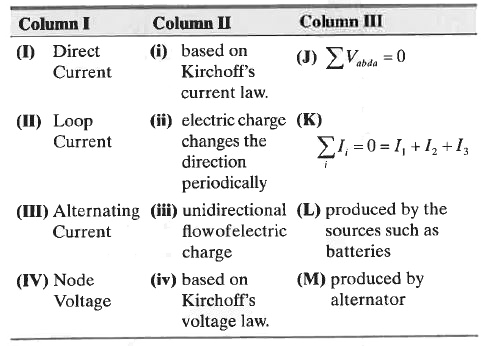
What does the graph signify?
View SolutionHow can we say that electric current is due to flow of charge?
View Solution
Knowledge Check
Electric current flows
Afrom lower to higher potentialBfrom higher potential to lower potentialCdepends on the materialDin all directionsElectrical current is the flow of charged particles. The electric current flows through a wire the same way as how water moves in a river. The electricity is nothing but the flow of electrons.
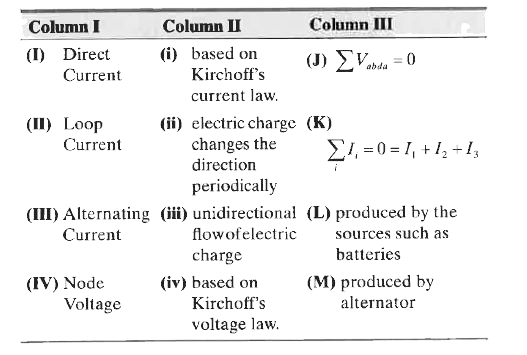
What does the graph signify?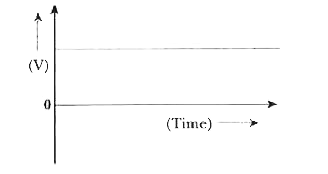 A(II) (iv) (J)B(IV) (i) (M)C(I) (ii) (L)D(III) (iv) (K)
A(II) (iv) (J)B(IV) (i) (M)C(I) (ii) (L)D(III) (iv) (K)Electrical current is the flow of charged particles. The electric current flows through a wire the same way as how water moves in a river. The electricity is nothing but the flow of electrons.
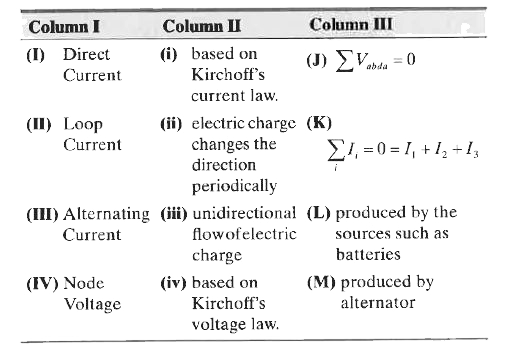
What does the circuit diagram signify? A(III) (i) (K)B(IV) (i) (J)C(III) (iii) (M)D(III) (ii) (M)
A(III) (i) (K)B(IV) (i) (J)C(III) (iii) (M)D(III) (ii) (M)
Electric current flows from ______terminal to _______terminal outside the cell through a circuit.
View SolutionElectrical current is the flow of charged particles. The electric current flows through a wire the same way as how water moves in a river. The electricity is nothing but the flow of electrons. There are two main combinations of resistors in circuit, that is series and parallel. In the given table, Column I shows different combinations of resistors, Column II shows voltages of different arrangements of resistors and Column III shows currents and voltage division needed or not in different arrangements of resistors.
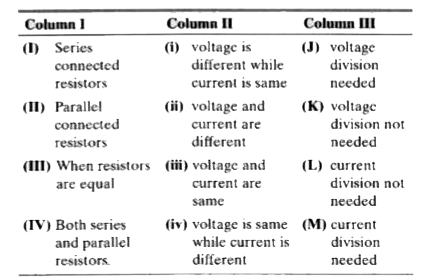
When does the current division problem arise?
View SolutionElectrical current is the flow of charged particles. The electric current flows through a wire the same way as how water moves in a river. The electricity is nothing but the flow of electrons. There are two main combinations of resistors in circuit, that is series and parallel. In the given table, Column I shows different combinations of resistors, Column II shows voltages of different arrangements of resistors and Column III shows currents and voltage division needed or not in different arrangements of resistors.
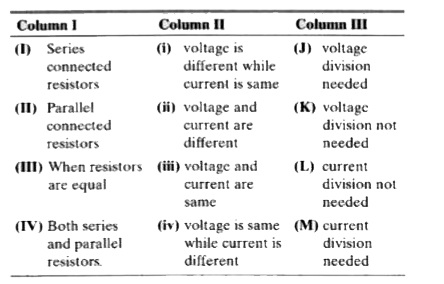
When there is no voltage division problem arise?
View SolutionElectrical current is the flow of charged particles. The electric current flows through a wire the same way as how water moves in a river. The electricity is nothing but the flow of electrons. There are two main combinations of resistors in circuit, that is series and parallel. In the given table, Column I shows different combinations of resistors, Column II shows voltages of different arrangements of resistors and Column III shows currents and voltage division needed or not in different arrangements of resistors.
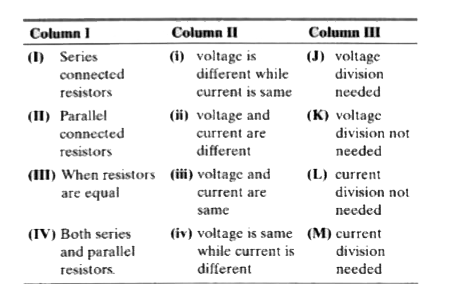
When does the voltage division problem arise?
View SolutionElectric current can flow through
View Solution
